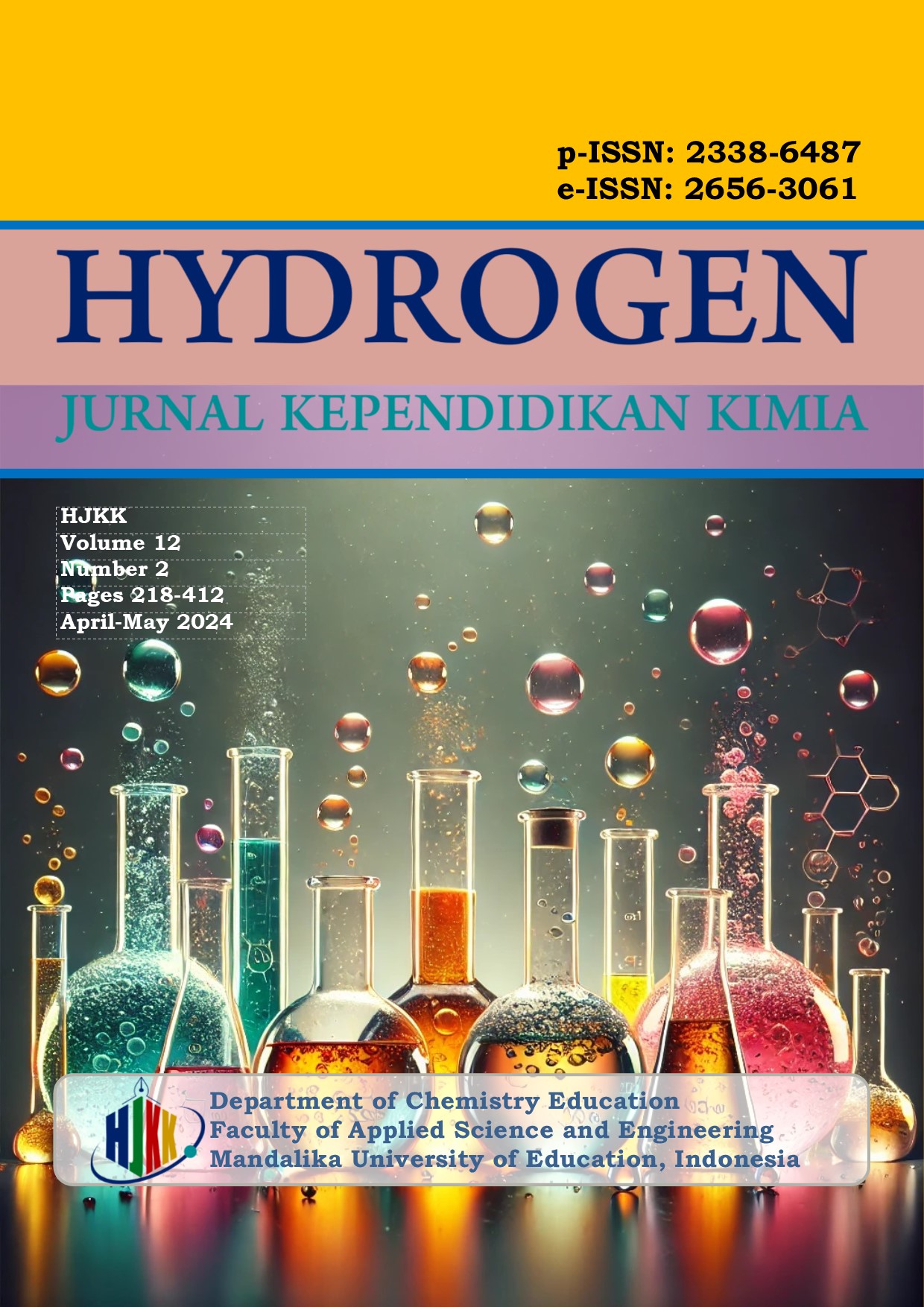Exploring Integrated Instrument Complement at Practical Approach at MAN 4 Tanah Datar
DOI:
https://doi.org/10.33394/hjkk.v12i2.10992Keywords:
4-D, design, exploring, components thermochemicalAbstract
The purpose of this research is to produce Integrated Instrument Components. Exploring integrated instrument complement at practical approach at MAN 4 Tanah Datar which is valid and practical. This study uses the Research and Development research method with the 4-D development model (define, design, develop, and disseminate). But the stages in research with this 4-D model are only carried out from the first to the third stage, namely the define stage to get conditions in the field. design stage to prepare a simple practicum kit on Thermochemistry material, and the develop stage to get the results of the initial practicum IIC that has been designed followed by validity and practicality tests. The research instruments used were validation sheets and response questionnaire sheets. The validation sheet was filled in by 2 lecturers and 1 chemistry educator. The response questionnaire sheet was filled by 17 of in 11th grade students of MAN 4 Tanah Datar. The results showed that: 1) Simple Practical IIC on Thermochemical Material has met the valid criteria with 92% validation results, 2) Simple Practical IIC on Thermochemical Material has met the practical criteria with the results of the student response questionnaire.
References
Adriani, Nina. 2016. “KOMPETENSI GURU DAN PESERTA DIDIK.†4(1).
Andani, S. P., E. R. Mawarnis, and M. Herman. 2023. “Development of Learning Videos Using Wondershare Filmora Software on Acid and Base Material at SMAN 1 Sungayang.†47–55.
Diah, H. 2023. “Innovative Teaching Tools : Creating a Guided Inquiry Chemistry E-Module with FLIP PDF Support for Understanding Atom Developmentand the Periodic System of Elements.†119–29.
Ipa, Jurnal, Cindi Patika Sari, Raudhatul Fadhilah, and Dedeh Kurniasih. 2022. “Validitas Alat Praktikum Kimia Berbasis Bahan Bekas Pada Materi Termokimia Pendahuluan.†6(2):130–44. doi: 10.24815/jipi.v6i2.24907.
Kimia, Praktikum, Berbasis Guided, Inquiry Pada, and Materi Asam Basa. 2021. “Pengembangan Kit (Komponen Instrumen Terpadu) Praktikum Kimia Berbasis Guided Inquiry Pada Materi Asam Basa 1,2,3.†5(2):149–58.
Kit, Pengembangan, and Hukum-hukum Dasar Kimia. 2017. “Journal of Innovative Science Education.†6(1).
Lampung, Fkip Universitas, Jl Prof, and Soemantri Brojonegoro. 2016. “View Metadata, Citation and Similar Papers at Core.ac.uk.†280–92.
Langsa, S. M. A. Negeri. 2022. “E -ISSN: 2721-9038 P-ISSN: 2721-902X.†5(2):42–45.
Mauliza, Mauliza, and Nurhafidhah Nurhafidhah. 2018. “Pengaruh Kesiapan Terhadap Pemanfaatan Laboratorium Pada Pelaksanaan Praktikum Kimia Di SMA Se Kota Langsa.†Jurnal Pendidikan Sains Indonesia 6(2):83–89. doi: 10.24815/jpsi.v6i2.12071.
Mawarnis, Elvy Rahmi, Mimi Herman, and Sumatera Barat. 2023. “Development of a Practicum Module Oriented to Chemoentrepreneurship with Qur’an and Hadist Insight on Colloidal System Material.†11(August).
Mawarnis, Elvy Rahmi, Syafmiati Khaira, and Mohd Yusri Abd. 2023. Development of Constructivism-Based Pictorial Chemistry Cards on Electrolyte and Non-Electrolyte Solution Materials. Vol. 1. Atlantis Press SARL.
Mawarnis, Elvy Rahmi, Suci Ramadhani, and Mimi Herman. 2023. Development of Module Integrated with Quranic Verses Based on Discovery Learning on Reaction Rate Material. Atlantis Press SARL.
Mawarnis, Elvy Rahmi, Akrajas Ali Umar, Masahiko Tomitori, Aamna Balouch, Muhammad Nurdin, Muhammad Zakir Muzakkar, and Munetaka Oyama. 2018. “Hierarchical Bimetallic AgPt Nanoferns as High-Performance Catalysts for Selective Acetone Hydrogenation to Isopropanol.†doi: 10.1021/acsomega.8b01268.
Merlinda, Sinta. 2019. “Pengembangan Media Video Pembuatan Kerajinan Bantalan Jarum Dari Limbah Hasil Jahitan Busana Untuk Siswa Kelas X Di SMK Muhammadiyah 1 Tempel.†(2008):13–69.
Nadila, Mutiara, Elvy Rahmi Mawarnis, Teacher Training, Mahmud Yunus Batusangkar, and Sumatera Barat. 2023. “Decoding The Obstacles of 10th Grade Student Learning in Atomic Structure at SMAN 1 Sungai Tarab.†11(December).
Novikasari, Ifada. 2017. “Uji Validitas Instrumen.†Seminar Nasional Riset Inovatif 2017 1(1):530–35.
Downloads
Published
How to Cite
Issue
Section
Citation Check
License
License and Publishing Agreement
In submitting the manuscript to the journal, the authors certify that:
- They are authorized by their co-authors to enter into these arrangements.
- The work described has not been formally published before, except in the form of an abstract or as part of a published lecture, review, thesis, or overlay journal.
- That it is not under consideration for publication elsewhere,
- That its publication has been approved by all the author(s) and by the responsible authorities – tacitly or explicitly – of the institutes where the work has been carried out.
- They secure the right to reproduce any material that has already been published or copyrighted elsewhere.
- They agree to the following license and publishing agreement.
Copyright
Authors who publish with Hydrogen: Jurnal Kependidikan Kimia agree to the following terms:
- Authors retain copyright and grant the journal right of first publication with the work simultaneously licensed under a Creative Commons Attribution License (CC BY-SA 4.0) that allows others to share the work with an acknowledgment of the work's authorship and initial publication in this journal.Â
- Authors are able to enter into separate, additional contractual arrangements for the non-exclusive distribution of the journal's published version of the work (e.g., post it to an institutional repository or publish it in a book), with an acknowledgment of its initial publication in this journal.
- Authors are permitted and encouraged to post their work online (e.g., in institutional repositories or on their website) prior to and during the submission process, as it can lead to productive exchanges, as well as earlier and greater citation of published work.
Licensing for Data Publication
Hydrogen: Jurnal Kependidikan Kimia uses a variety of waivers and licenses, that are specifically designed for and appropriate for the treatment of data: Open Data Commons Attribution License, http://www.opendatacommons.org/licenses/by/1.0/ (default) Other data publishing licenses may be allowed as exceptions (subject to approval by the editor on a case-by-case basis) and should be justified with a written statement from the author, which will be published with the article.







